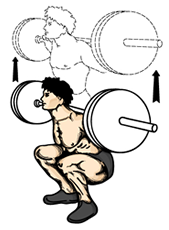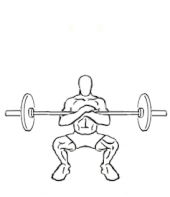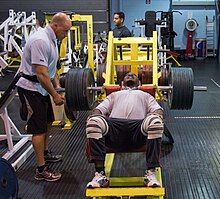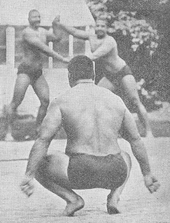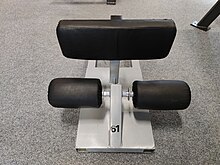
Weightlifting is a sport in which athletes compete in lifting a barbell loaded with weight plates from the ground to overhead, with the aim of successfully lifting the heaviest weights. Athletes compete in two specific ways of lifting the barbell overhead. The snatch is a wide-grip lift, in which the weighted barbell is lifted overhead in one motion. The clean and jerk is a combination lift, in which the weight is first taken from the ground to the front of the shoulders, and then from the shoulders to over the head. The sport formerly included a third lift/event known as clean and press.

Powerlifting is a strength sport that consists of three attempts at maximal weight on three lifts: squat, bench press, and deadlift. As in the sport of Olympic weightlifting, it involves the athlete attempting a maximal weight single-lift effort of a barbell loaded with weight plates. Powerlifting evolved from a sport known as "odd lifts", which followed the same three-attempt format but used a wider variety of events, akin to strongman competition. Eventually, odd lifts became standardized to the current three.

The clean and jerk is a composite of two weightlifting movements, most often performed with a barbell: the clean and the jerk. During the clean, the lifter moves the barbell from the floor to a racked position across the deltoids, without resting fully on the clavicles. During the jerk, the lifter raises the barbell to a stationary position above the head, finishing with straight arms and legs, and the feet in the same plane as the torso and barbell.

The bench press, or chest press, is a weight training exercise where a person presses a weight upwards while lying horizontally on a weight training bench. The bench press is a compound movement, with the primary muscles involved being the pectoralis major, the anterior deltoids, and the triceps brachii. Other muscles located in the back, legs and core are involved for stabilization. A barbell is generally used to hold the weight, but a pair of dumbbells can also be used.

A barbell is a piece of exercise equipment used in weight training, bodybuilding, weightlifting, powerlifting and strongman, consisting of a long bar, usually with weights attached at each end.

Strength training, also known as weight training or resistance training, involves the performance of physical exercises that are designed to improve strength and endurance. It is often associated with the lifting of weights. It can also incorporate a variety of training techniques such as bodyweight exercises, isometrics, and plyometrics.

The deadlift is a weight training exercise in which a loaded barbell or bar is lifted off the ground to the level of the hips, torso perpendicular to the floor, before being placed back on the ground. It is one of the three powerlifting exercises, along with the squat and bench press, as well as a frequent lift in strongman. It is also occasionally used in armlifting.

An isometric exercise is an exercise involving the static contraction of a muscle without any visible movement in the angle of the joint. The term "isometric" combines the Greek words isos (equal) and -metria (measuring), meaning that in these exercises the length of the muscle and the angle of the joint do not change, though contraction strength may be varied. This is in contrast to isotonic contractions, in which the contraction strength does not change, though the muscle length and joint angle do.
The snatch is the first of two lifts contested in the sport of weightlifting followed by the clean and jerk. The objective of the snatch is to lift the barbell from the ground to overhead in one continuous motion. There are four main styles of snatch used: snatch, split snatch, power snatch, and muscle snatch. The full lift is the most common style used in competition, while power snatches and muscle snatches are mostly used for training purposes, and split snatches are rarely used. Any of these lifts can be performed from the floor, from the hang position, or from blocks. In competition, only lifts from the floor are allowed.

In weight training, a kettlebell is a cast-iron or cast-steel ball with a handle attached to the top. It is used to perform many types of exercises, including ballistic exercises that combine cardiovascular, strength and flexibility training. Kettlebells are the primary equipment used in the weight-lifting sport of kettlebell lifting.
The good-morning is a weight training exercise. It is known as a good morning because of the movement in the erector spinae which resembles the bow that traditionally begins a schoolday in some East-Asian countries. The erector spinae muscles of the lower back work isometrically to keep the spine in an extended position while the hamstrings and gluteus maximus work isotonically to perform hip extension. Other muscles are involved in stabilizing weight on the back and maintaining balance.
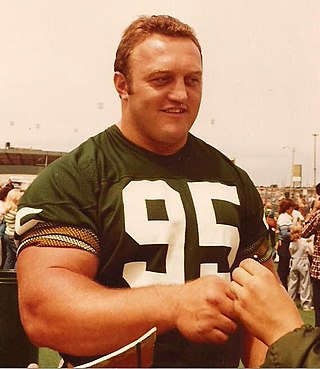
William Kazmaier is an American former world champion powerlifter, world champion strongman and professional wrestler. During the 1970s and 1980s, he set numerous powerlifting and strongman world records, and won two International Powerlifting Federation (IPF) World Championships and three World's Strongest Man titles. In the 1980s, Kazmaier became famous for his claim to be "the strongest man who ever lived" by equaling and surpassing spectacular and versatile feats of strength of famous strongmen of the 20th century. He is widely considered to be one of the all-time greatest competitors in strength competitions and was inducted into the International Sports Hall of Fame in 2017.
One-repetition maximum in weight training is the maximum amount of weight that a person can possibly lift for one repetition. It may also be considered as the maximum amount of force that can be generated in one maximal contraction.
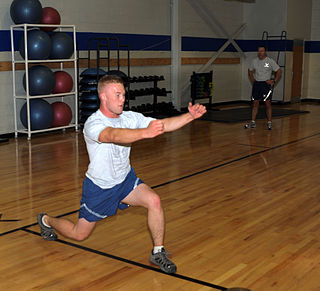
A lunge can refer to any position of the human body where one leg is positioned forward with knee bent and foot flat on the ground while the other leg is positioned behind. It is used by athletes in cross-training for sports, by weight-trainers as a fitness exercise, and by practitioners of yoga as part of an asana regimen.
Calf raises are a method of exercising the triceps surae, tibialis posterior, and peroneal muscles of the lower leg. The movement performed is plantar flexion, also called ankle extension.

The leg raise is a strength training exercise which targets the iliopsoas. Because the abdominal muscles are used isometrically to stabilize the body during the motion, leg raises are also often used to strengthen the rectus abdominis muscle and the internal and external oblique muscles.
Louie Simmons was an American powerlifter and strength coach. He was active as a powerlifter and coach for more than fifty years. Simmons was the founder of Westside Barbell and has developed several training protocols, including the "Conjugate Method". He is also credited with inventing training machines for reverse hyper-extensions and belt squats. In the US powerlifting community he was referred to as the "Godfather of powerlifting".
The hang clean is a weightlifting exercise involving the use of a barbell to do a compound series of strength-building movements.

Power training typically involves exercises which apply the maximum amount of force as fast as possible; on the basis that strength + speed = power. Jumping with weights or throwing weights are two examples of power training exercises. Regular weight training exercises such as the clean and jerk and power clean may also be considered as being power training exercises due to the explosive speed required to complete the lifts. Power training may also involve contrasting exercises such as heavy lifts and plyometrics, known as complex training, in an attempt to combine the maximal lifting exertions with dynamic movements. This combination of a high strength exercise with a high speed exercise may lead to an increased ability to apply power. Power training frequently specifically utilises two physiological processes which increase in conjunction with one another during exercise. These are deep breathing, which results in increased intra-abdominal pressure; and post-activation potentation, which is the enhanced activation of the nervous system and increased muscle fibre recruitment. Power training programmes may be shaped to increase the trainee's ability to apply power in general, to meet sports specific criteria, or both.


